

The second model in the "Ultra-Realistic Paper Crafts" series, released in December 2009. Like the first, the MT-01, it is very large, and has very many parts.
Unlike the MT-01, the whole model was released at once, though like the MT-01 in five separate volumes, each consisting of a PDF parts file and a PDF assembly instruction file:
| File | Pages | Assembly | Pages | Parts |
|---|---|---|---|---|
| 1 | 11 | A - Engine | 10 | 189 |
| B - Intake1 | 1 | 27 | ||
| 2 | 13 | C - Frame | 6 | 116 |
| D - Rear Arm | 3 | 53 | ||
| E - Rear Fender | 2.5 | 17 | ||
| F - Fuel Tank | 1.5 | 6 | ||
| 3 | 6 | G - Steering | 3 | 91 |
| H - Head Light | 0.5 | 14 | ||
| I - Meter | 0.5 | 11 | ||
| J - Intake2 | 2 | 28 | ||
| 4 | 8 | K - Exhaust Pipes | 3 | 79 |
| L - Radiator | 2 | 37 | ||
| M - Side Covers | 2 | 24 | ||
| N - Seat | 1 | 4 | ||
| 5 | 9 | O - Front Tire | 4 | 28 |
| P - Rear Tire | 4 | 30 | ||
| Q - Rear Flasher Light | 0.5 | 17 | ||
| R - Stand | 0.5 | 10 | ||
| Total | 47 | 47 | 781 |
As usual, Yamaha do not specify a scale, but comparison with the old (1998) VMAX model strongly suggests that the scale is the same as that of the MT-01, that is 1:5.5. I have therefore built the model 39% of the original size, so that it comes out the same scale as all my other Yamaha motorcycle models, i.e. 1:14.
I had a fair amount of difficulty with the parts. Firstly, several parts show somewhat weird unfoldings (for example C12 and C13, L10, M23 and M24) which look very much like automatic unfolding from e.g. Pepakura. Against this, there are several major shape and fit problems which should not arise if there is a true 3D model. The most obvious examples of shape problems are in the rear part of the frame (parts C84-C99). The even numbers form the left-hand side, and the odd numbers the right, and they should be symmetric. Parts C84 and C85 are clearly not mirror images of each other, and C84 cannot be made up without introducing a major twist. Parts C96 and C97 are likewise. In May 2010, Yamaha posted a set of "corrected" parts files, which fix the problem with C96, but not C84. In fact the corrections were mostly very minor, like changing mountain fold markings to valley folds.
I made one major change to the model. I redrew the tyres to use a "petal" construction instead of the usual multiple-ring construction. This was as a result of trying out this method on the Atelier Fare Police Bike (q.v.) The result is pleasingly-rounded profiles, though at the cost of multiple radial cuts where the petals meet. Surprisingly, this style of tyre is probably no more difficult to construct than the ring style - perhaps easier even when there are many narrow rings, as with this model.
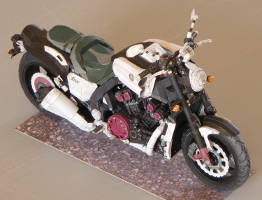
|
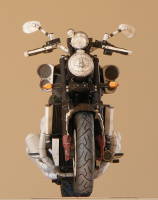
|
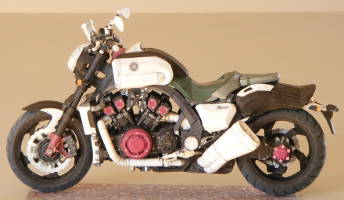
|
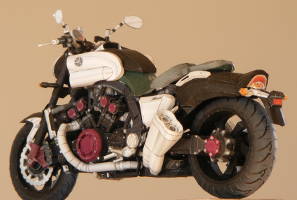
|
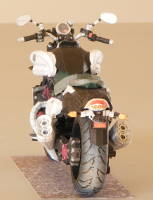
|
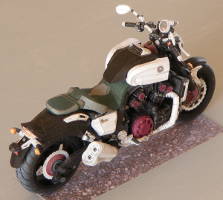
|